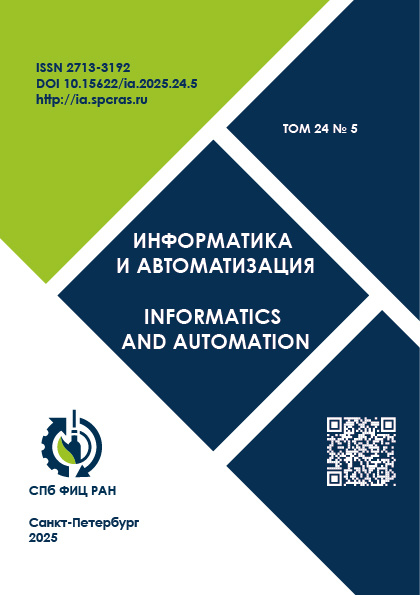Решение многокритериальной задачи рационального размещения несущих стен с помощью генетического алгоритма
- Авторы: Зинов В.И1, Картак В.М1, Валиахметова Ю.И1
-
Учреждения:
- Уфимский университет науки и технологий
- Выпуск: Том 24, № 2 (2025)
- Страницы: 464-491
- Раздел: Математическое моделирование и прикладная математика
- URL: https://journal-vniispk.ru/2713-3192/article/view/289694
- DOI: https://doi.org/10.15622/ia.24.2.4
- ID: 289694
Цитировать
Полный текст
Аннотация
Об авторах
В. И Зинов
Уфимский университет науки и технологий
Email: zinovvladislavufa@gmail.com
улица Заки Валиди 32
В. М Картак
Уфимский университет науки и технологий
Email: kvmail@mail.ru
улица Заки Валиди 32
Ю. И Валиахметова
Уфимский университет науки и технологий
Email: julikas@inbox.ru
улица Заки Валиди 32
Список литературы
- Petprakob W. Beam-slab floor optimization using genetic and particle swarm optimization algorithms // A Thesis for degree of master of science in engineering and technology. Thailand: Thammasat University, Sirindhorn International Institute of Technology. 2014. 90 p. doi: 10.14457/TU.the.2014.490.
- Nimtawat A., Nanakorn P. Automated layout design of beam-slab floors using a genetic algorithm // Computers & Structures. 2009. vol. 87(21-22). pp. 1308–1330. doi: 10.1016/j.compstruc.2009.06.007.
- Sharafi P. Cost optimization of the preliminary design layout of reinforced concrete framed buildings // A Thesis for degree of Doctor of Philosophy in civil engineering. Australia: University of Wollongong, School of Civil, Mining and Environmental Engineering. 2013. 286 p.
- Hadi M.H., Sharafi P., Teh L.H. A new formulation for the geometric layout optimisation of flat slab floor systems // Proceeding of the Australasian Structural Engineering Conference 2012: The Past, Present and Future of Structural Engineering. Perth, Western Australia: Engineers Australia, 2012. pp. 122–129. doi: 10.3316/informit.026275045488938.
- Sahab M.G., Ashour A.F., Toropov V.V. Cost optimisation of reinforced concrete flat slab buildings // Engineering Structures. 2005. vol. 27(3). pp. 313–322. doi: 10.1016/j.engstruct.2004.10.002.
- Meng X., Lee T.U., Xiong Y., Huang X., Xie Y.M. Optimizing support locations in the roof–column structural system // Applied Science. 2021. vol. 11(6). doi: 10.3390/app11062775.
- Zelickman Y., Amir O. Optimization of column layouts in buildings considering structural and architectural constraints // Engineering Archive (engrXiv). 2024. 45 p. doi: 10.31224/2723.
- Steiner B., Mousavian E., Mehdizadeh Saradj F., Wimmer M., Musialski P. Integrated structural-architectural design for interactive planning // Computer Graphics Forum. 2016. vol. 36(8). pp. 80–94. doi: 10.1111/cgf.12996.
- Валиахметова Ю.И., Васильева Л.И., Зинов В.И. Алгоритм решения задачи определения рационального плана размещения несущих конструкций при строительстве многоэтажных зданий // Современные проблемы и перспективы развития естествознания: Сб. научн. тр. Национальной научно-практической конференции (г. Уфа, 8–9 июня 2020 г.). Т. 2. Уфа: БГПУ. 2020. С. 46–54.
- Eleftheriadis S., Duffour P., Stephenson B., Mumovic D. Automated specification of steel reinforcement to support the optimisation of RC floors // Automation in Construction. 2018. vol. 96. pp. 366–377. doi: 10.1016/j.autcon.2018.10.005.
- Wang J., Chen K., Yang H., Zhang L. Ensemble deep learning enabled multi-condition generative design of aerial building machine considering uncertainties // Automation in Construction. 2024. vol. 157. doi: 10.1016/j.autcon.2023.105134.
- Лешкевич О.Н. Использование искусственных нейронных сетей для оценки армирования железобетонных плит перекрытия // Проблемы современного бетона и железобетона: Сб. научн. тр. № 11. Минск: Ин-т БелНИИС, 2019. С. 51–62. doi: 10.35579/2076-6033-2019-11-04.
- Liao W.J., Lu X.Z., Fei Y.F., Gu Y., Huang Y.L. Generative AI design for building structures // Automation in Construction. 2024. vol. 157. doi: 10.1016/j.autcon.2023.105187.
- Зинов В.И., Картак В.М., Валиахметова Ю.И. Алгоритм оценки деформации плит перекрытий по пролетно-опорным схемам здания // Системы анализа и обработки данных. 2023. № 4(92). С. 35–54. doi: 10.17212/2782-2001-2023-4-35-54.
- Long Q., Wu C.Z., Wang X.Y., Jiang L., Li J. A multiobjective genetic algorithm based on a discrete selection procedure // Mathematical Problems in Engineering. 2015. vol. 2015. 17 p. doi: 10.1155/2015/349781.
- Валиахметова Ю.И., Прокудина Е.И., Зинов В.И. Многокритериальный генетический алгоритм решения задачи рационального размещения опорных конструкций на плане зданий // Современные физика, математика, цифровые и нанотехнологии в науке и образовании: Сб. научн. тр. II Всероссийской молодежной школы-конференции (г. Уфа, 18–20 апреля 2023 г.). Уфа: БГПУ, 2023. С. 95–100.
- Rahimi I., Gandomi A.H., Nikoo M.R., Chen F. A comparative study on evolutionary multi-objective algorithms for next release problem // Applied Soft Computing. 2023. vol. 144. doi: 10.1016/j.asoc.2023.110472.
- Srinivas N., Deb K. Muiltiobjective optimization using nondominated sorting in genetic algorithms // Evolutionary Computation. 1994. vol. 2(3). pp. 221–248. doi: 10.1162/evco.1994.2.3.221.
- Deb K., Pratap A., Agarwal S., Meyarivan T. A fast and elitist multiobjective genetic algorithm: NSGAII // IEEE Transactions on Evolutionary Computation. 2002. vol. 6(2). pp. 182–197. doi: 10.1109/4235.996017.
- Zitzler E., Laumanns M., Thiele L. SPEA2: Improving the strength Pareto evolutionary algorithm // TIK-Report. 2001. vol. 103. doi: 10.3929/ethz-a-004284029.
- Liu M., Zou X., Chen Y., Wu Z. Performance assessment of DMOEA-DD with CEC 2009 MOEA Competition Test Instances // Proceeding of the IEEE Congress on Evolutionary Computation (CEC 2009). Norway: Trondheim, 2009. pp. 2913–2918. doi: 10.1109/CEC.2009.4983309.
- He M., Wang X., Chen H., Li X. A Knee Point-Driven Many-Objective Evolutionary Algorithm with Adaptive Switching Mechanism // Journal of Applied Mathematics. 2024. vol. 2024(1). 43 p. doi: 10.1155/2024/4737604.
- Ester M., Kriegel H.-P., Sander J., Xu X. A density-base algorithm for discovering clusters in large spatial databases with noise // Proceeding of 2nd International Conference on Knowledge Discovery and Data Mining (KDD-96). Germany: Munich, 1996. pp. 226–231.
Дополнительные файлы










